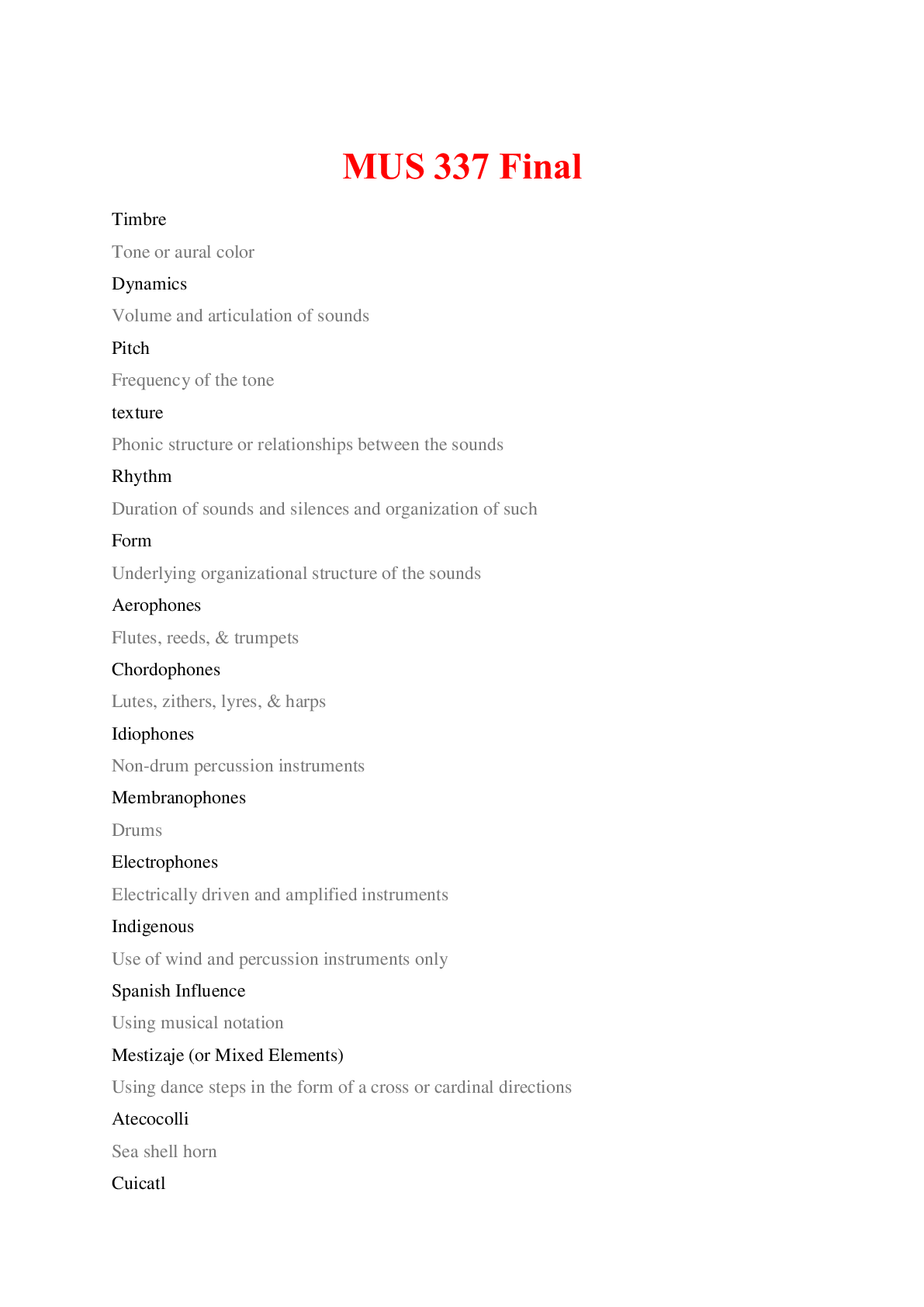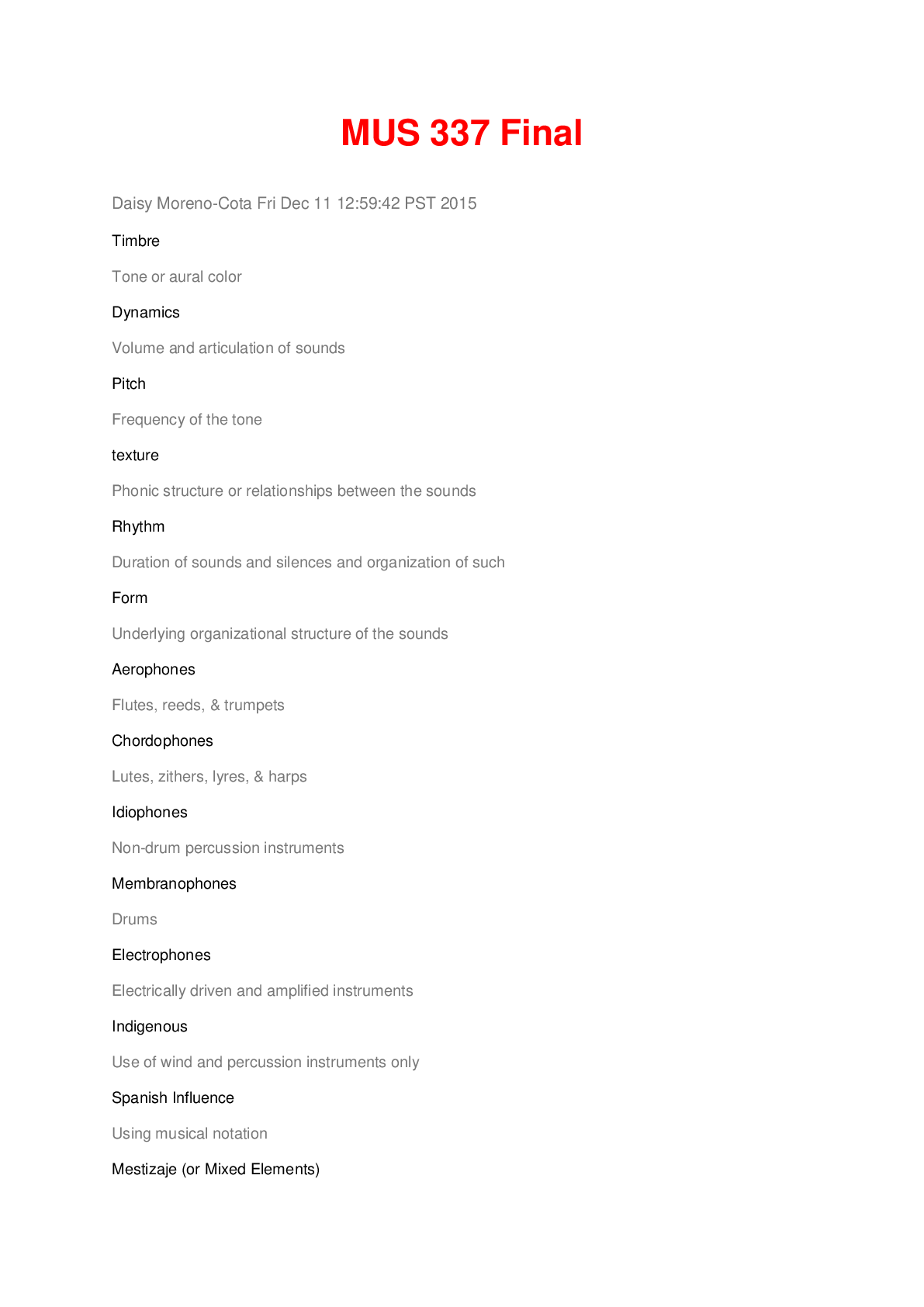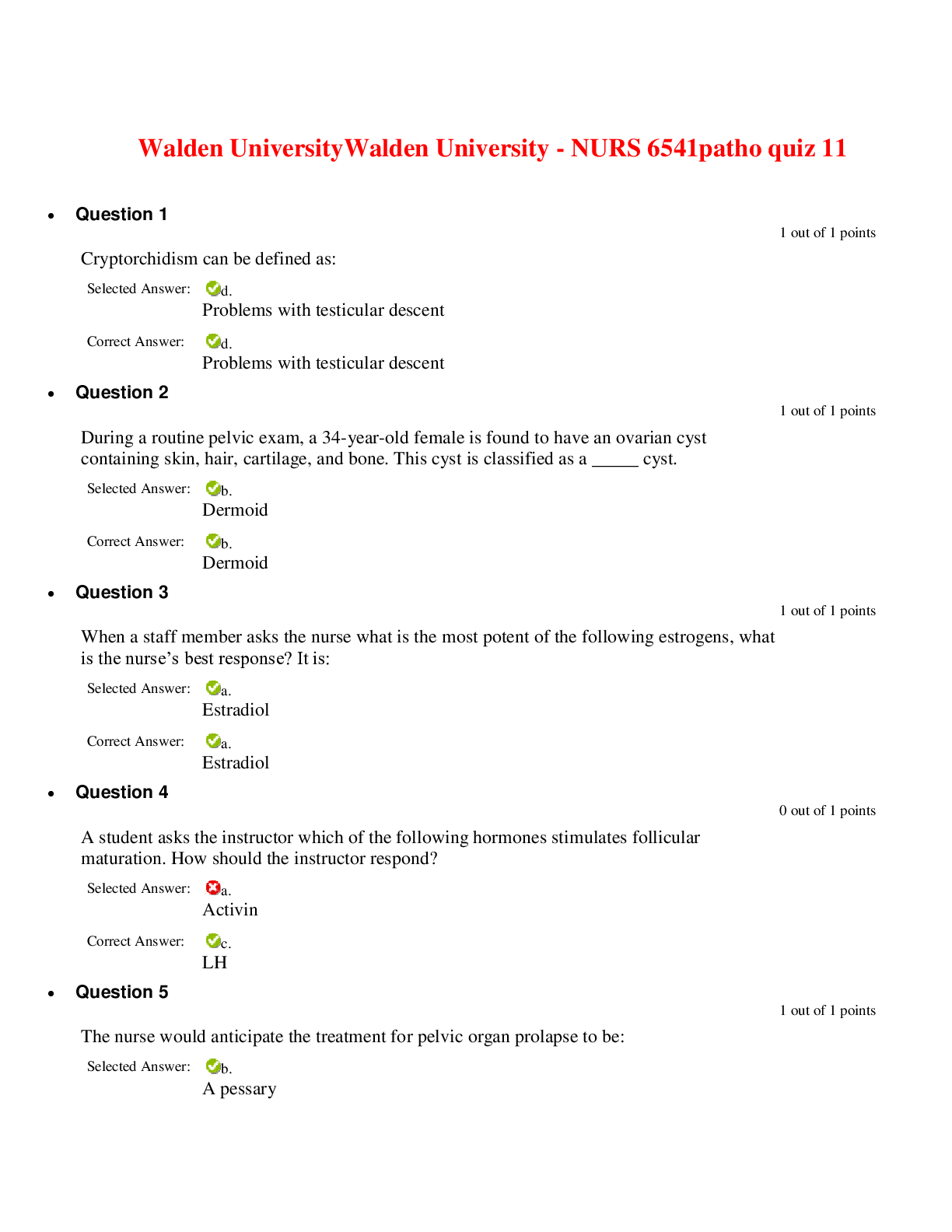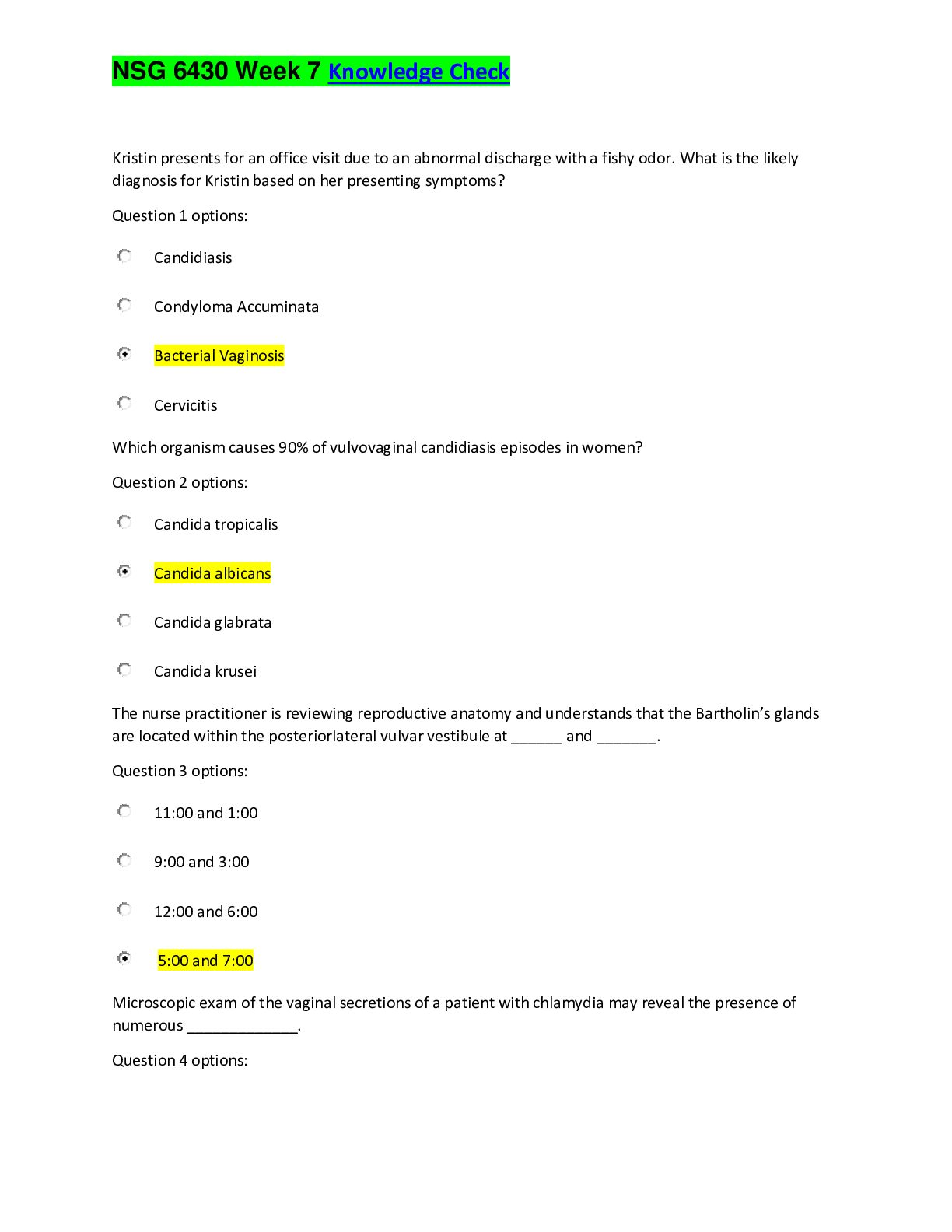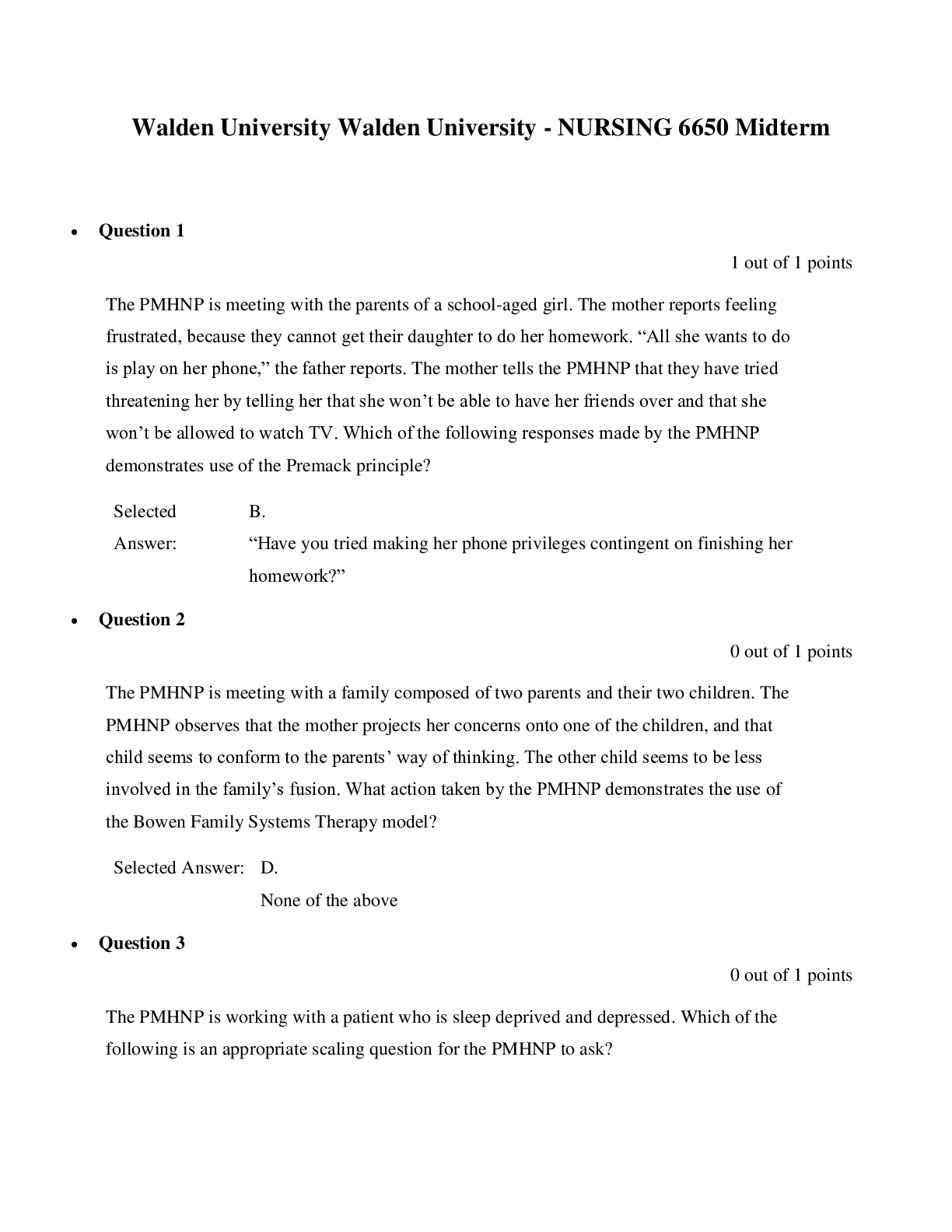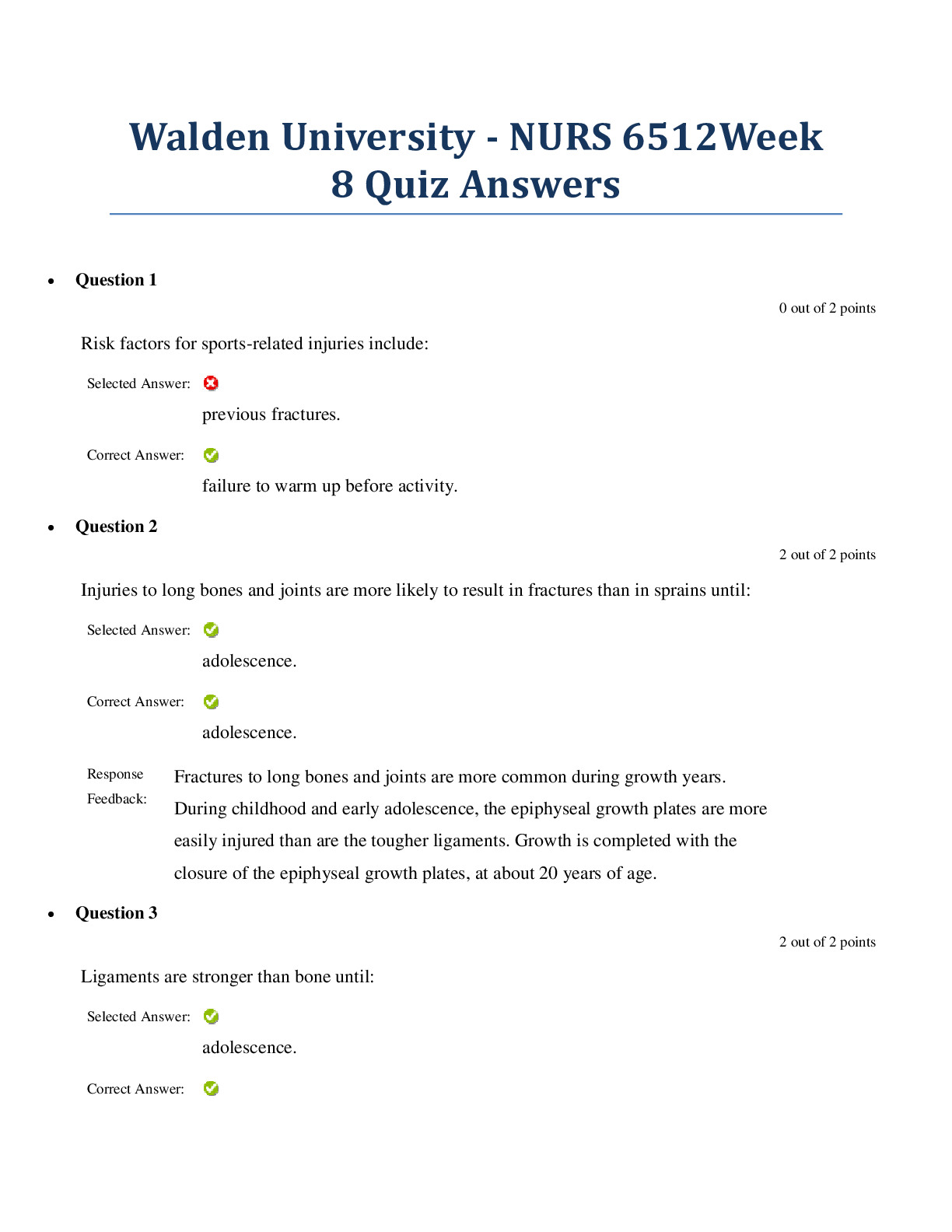*NURSING > QUESTIONS & ANSWERS > Walden UniversityWalden University - NURS 6550N Final Exam.docx Hematologic/Lymphatic/Immune System (All)
Walden UniversityWalden University - NURS 6550N Final Exam.docx Hematologic/Lymphatic/Immune System
Document Content and Description Below
Walden UniversityWalden University - NURS 6550N Final Exam.docx Hematologic/Lymphatic/Immune System • Iron Deficiency Anemia o Most common cause of anemia world wide o Signs and Symptoms ... Fatigue Tachycardia Palpations Dyspnea on exertion Severe deficiency causes skin and mucosal changes (smooth tongue, brittle nails, spooning of nails) Pica (craving non-iron foods o Laboratory Findings Develops in stages o First is depletion of iron stores without anemia followed by anemia with normal red blood cell size (normal MCV) followed by anemia with reduced MCV Ferritin: value of less than 12 ng/mL is a highly reliable indicator of reduced iron stores. Anyone who is less than 30 ng/mL almost always indicates iron deficiency in anyone who is anemic. Platelet: commonly increased but usually remains under 800,000 mcL o Differential Dx: anemia of chronic disease, thalassemia, lead poisoning, congenital X-linked sideroblastic anemia o Treatment: Oral Iron: 325 mg ferrous sulfate on empty stomach. Results usually seen within 2 weeks. Continue treatment for 3-6 months Parenteral Iron: Indicated for intolerance of or refractoriness to oral iron. Most patients require 1-1.5 g • Anemia of Chronic Disease o Signs and Symptoms Clinical features are those of the causative condition o Labs Hct rarely falls below 60% of baseline MCV usually normal or slightly reduced Red blood cell morphology is usually normal Reticulocyte count is mildly decreased or normal Ferritin normal or increased o Treatment In most cases no treatment of anemia is necessary, and the primary management is to address the condition causing the anemia RBC transfusions Epoetin alfa or darbepoetine (goal hgb between 10-12) • Thalassemia o Herediatry disorders characterized by reduction in the sysnthesis of globin chains (alpha or beta). o Alpha is due primarily to gene deletions causing reduced alpha-globin chain synthesis. o Beta is usually caused by point mutations rather than deletions. o Alpha Signs and Symptoms Normally adults have 4 copies of the alpha-globin chain. When 3 aplha-globin chains are present the patient is hematologically normal (silent carrier). When 2 alpha-globin chains are present will have mild microcytic anemia When only 1 alpha-globin chain is present (Hemoglobin H disease) physical exam may reveal pallor and splenomegaly. o Beta signs and symptoms Homozygous for beta thalassemia have thalassemia major. • Affected children will show signs after 6 months including stunted growth, bony deformities, hepatosplenomegaly, jaundice, and thrombophilia. Transfusions are needed but be watchful for transfusional iron overload. Patients homozygous for a milder form of beta thalassemia have thalassemia intermedia. Have chronic hemolytic anemia but do not require transfusions except under periods of stress or during aplastic crisis. o Labs Hallmark features are small (low MCV) and pale (low mean corpuscular hemoglobin MCH) red blood cells, anemia and a normal to elevated red blood cell count (ie, a large number of the small and pale red blood cells are being produced) Alpha-thalassemia trait. Mild anemia with Hct between 28-40%, MCV low 60-75 fL and red blood cell count is normal or increased. Hemoglobin H disease. More marked anemia with Hct 22-32%, MCV low at 60-70 fL, and peripheral blood smear is markedly abnormal with hypochromia, microcytosis, target cells and poikilosytosis. Beta-thalassemia minor. Modest anemia with Hct between 28-40%, MCV ranges from 55-75 fL., red blood cell is normal to increased. Beta-thalassemia intermedia. Hct 17-33%, MCV 55-75 and red blood count is normal or increased. Reticulocyte count is elevated. Beta thalassemia major. Severe anemia and without transfusion the Hct will fall to less than 10%. Peripheral blood smear is bizarre showing severe poikilocytosis, hypochromia, microcytosis, target cells, basophilic stripping and nucleated red blood cells. o Differential Dx Iron deficiency anemia Dx of beta-thalassemia is made by the above findings and hemoglobin electrophoresis showing elevated levels of hemoglobins A2 and F. o Treatment Mild thalassemia (alph-thalassemia or beta-thalassemia minor): no treatment, evaluate regularly for iron deficiency. Hemoglobin H disease: folic acid, avoid medicinal iron, and oxidative drugs such as sulfonamides. Severe thalassemia: regular transfusion schedule, folic acid. Splenectomy is performed if hypersplenism causes a marked increase in the transfusion requirement or refractory symptoms. Patients with regular transfusions should be treated with iron chelation (oral or parenteral) in order to prevent life limiting organ damage from iron overload. • B12 Deficiency o Signs and symptoms Slow onset anemia, glossitis, anorexia, diarrhea, neurologic syndrome. o Labs Low serum B level. (Normal greater than 210, most with overt deficiency levels less than 170) o Differential Dx Folic acid deficiency, myelodysplastic syndrome, acute erythrocytic leukemia. o Treatment IM or subcu injections of 100mcg B12. Replacement is usually given daily for the 1 st week, weekly for a month and monthly for life. Oral or sublingual methylcobalamin (1 mg/day) may be used after correction is made. • Hemolytic Anemia • Hemolytic anemia is a disorder in which red blood cells are destroyed faster than they can be made. The destruction of red blood cells is called hemolysis. • 2 types including intrinsic or extrinsic factor The treatment for hemolytic anemia will vary depending on the cause of the illness. Treatment may include: • Blood transfusions • Corticosteroid medicines • Treatment to strengthen your immune system (using intravenous immune globulin) • Rituximab In more severe cases, the following treatments may be needed: • Surgery to remove the spleen • Medicine to reduce the strength of your immune system (immunosuppressive therapy) • Neutropenia • Causes o Bone marrow disorders: cyclic neutropenia, congenital neutropenia, hairy cell leukemia, myelodysplasia o Non-Bone marrow: medications (sulfonamides, chlorpromazine, procainamide, PCN, cephalosporins), aplastic anemia, myelosuppressive cytotoxic chemotherapy, hypersplenism, sepsis, HIV • Clinical findings o Results in stomatitis and in infections due to gram-positive or gram-negative bacteria or fungi such as candida or aspergillus. Most common infection syndromes are septicemia, cellulitis, pneumonia, and neutropenic fever of unknown origin. • Treatment o Stop potential causative medications o Autoimmune neutropenia often responds to immunosuppression with corticosteroids. o Fevers during neutropenia should be considered infectious until proven otherwise. o Enteric gram-negative bacteria are primary concern and should be treated empirically with fluoroquinolones or third- or fourth-generation cephalosporins. o Fungal infections are treated with “azoles” (fluconazole for yeast and voriconazole, itraconazole for molds) • Acute Leukemia • Classifications o Acute Myeloid (AML) o Acute Promyelocytic o Acute Lymphoblastic o Mixed Phenotype Acute Leukemias • Signs and symptoms o Most ill for only few days or weeks o Bleeding occurs in the skin and mucosal surfaces o Infection due to neutropenia o Gum hypertrophy o Bone and joint pain o Purpura and petechiae • Labs o Hallmark combination of pancytopenia with circulating blasts. o Hyperuricemia o Patients with ALL may have mediastinal mass visible on chest radiograph • Differential Dx • CML, toxic insult recovery, CLL, lymphoma, hairy cell leukemia. • Treatment o AML: combination of anthracycline plus cytarabine. o ALL: combination chemotherapy including daunorubicin, vincristine, prednisone, and asaraginase. This treatment produces 90% remission in patients. • Chronic Leukemia o Symptoms and signs CLL is a disease of older patients; 90% after age 50. Fatigue Lymphadenopathy Enlargement of liver or spleen o Labs Hallmark sign is isolated lymphocytes. WBC count is usually greater than 20,000 and may be markedly elevated to several hundred thousand o Differential Dx Viral infections, lymphoma, hairy cell leukemia, Walden-strom macroglobulinemia o Treatment Most early cases require no treatment, just monitor Indications for treatment include progressive fatigue, symptomatic lymphadenopathy, anemia or thrombocytopenia. Initial Tx for patients under 70 is chemotherapy with either fludarabine with cyclophosphamide and rituximab or bendamustine with rituximab. For older patients or young patients with significant co-morbidities, chlorambucil 0.6-1 mg/kg orally every 2-3 weeks has been standard. Watch for bleeding in patients taking coumadin • Non-Hodgkin Lymphoma • Signs and symptoms o Isolated or wide spread lymphandeonpathy o Fever o Drenching night sweats o Weight loss greater than 10% • Treatments o Indolent Lymphomas Most common in this group are follicular lymphoma, marginal zone lymphomas, and small lymphocytic lymphoma. Depend on the stage and clinical status of the patient Rituximab 375 mg IV weekly x 4 weeks. o Aggressive lymphomas o Patients with diffuse large B cell lymphoma are treated with curative intent o Most treated with six cycles of immunochemotherapy such as R-CHOP (R) rituximab (Rituxan) (C) cyclophosphamide (H) doxorubicin hydrochloride (O) vincristine (Oncovin, Vincasar PFS) (P) prednisolone • Prognosis o Median survival of patients with indolent lymphomas is 10-15 years • Hodgkin Lymphoma • Clinical findings o Bimodial age distribution peaking at age 20 and again at age 50 o Often seek medical care due to painless mass in neck o Fever o Weight loss o Drenching night sweats o Generalized pruritis • Treatment o Chemotherapy is the mainstay treatment with doxorubicin, bleomycin, vinblastine, and dacarbazine o Relapse after initial treatment is treatable with high dose chemotherapy and autologous hematopoietic stem cell transplantation • Prognosis o Cure rate is 75% with 0-2 risk factors and 55% with 3 or more risk factors including stage, age, gender, hemoglobin, albumin, white blood cell count, and lymphocyte count • Transfusion • Preparations o Whole blood o Packed red blood cells o Leukocyte poor blood o Autologous packed red blood cells • Compatibility Testing o A and B antigens are the most important o In emergencies type O/ Rh negative blood can be given to anyone • Hemolytic transfusion reaction o Most severe reaction o May last up to 5-10 days after transfusion o Signs and symptoms Fever, chills, backache and headache, dyspnea, hypotension and cardiovascular collapse. Patients under anesthesia will not manifest such symptoms and the 1st indication may be tachycardia, generalized bleeding or oliguria. o Labs Coagulation studies may reveal AKI or DIC Delayed hemolytic reaction will have unexpected Hgb drop, increase in the total and direct bilirubin o Treatment Stop transfusion immediately. Hydrate vigorously Forced diuresis with mannitol may help prevent or minimize AKI • Leukoaggutinin Reactions o Occurs due to transfusion products relatively rich in leukocyte-rich plasma, especially platelets. o Fever and chills within 12 hours. In severe cases cough and dyspnea. o Acetaminophen, Benadryl, corticosteroids • Hypersensitivity Reaction o Urticaria or bronchospasm may develop during or soon after transfusion. o These reactions are almost always due to exposure to allergic plasma proteins rather than leukocytes o May require transfusion of washed or even frozen red blood cells to avoid future reactions • Contaminated blood o Blood products can be contaminated with bacteria, platelets being the most prone since they are unable to be refrigerated o Recipient of blood product contaminated with gram negative bacteria often causes septic shock, acute DIC and AKI due to the transfused endotoxin and is often fatal. o Blood from both recipient and blood bag need to be cultured and antibiotics started immediately • Infectious disease transmission through transfusion o Any blood can still transmit viral disease including Hep B & C, HIV, west nile virus and zika • Transfusion graft vs host disease o Allogenic passenger lymphocytes within transfused blood products will engraft in some recipients and mount an alloimmune attack against tissues expressing discrepant HLA antigens causing graft-versus-host disease (GVHD). o Symptoms include fever, rash, diarrhea, hepatitis, lymphadenopathy, and severe pancytopenia. o Normally fatal • Transfusion related acute lung injury o Occurs in 1 in every 5000 units transfused o Clinically defined as noncardiac pulmonary edema after receiving blood. o No specific treatment, just supportive care • Platelet Transfusion o A single donor should raise the platelet count by 50,000 to 60,000 per mcL o Transfused platelets typically last for 2-3 days • Transfusion of plasma components o Fresh frozen plasma (FFP): used to correct coagulation factor deficiencies and to treat thrombotic thrombocytopenia purpura or hemolytic uremic syndrome. Also used to correct or prevent coagulopathy in trauma patients with a ratio of 1 FFP to every 2 PRBC o Cryoprecipitate: made from FFP by cooling plasma to 4 degrees C and collecting the precipitate. 1 unit has a volume of approx. 250 mg of fibrinogen and between 80 to 100 units of factor VIII and von Wille-brand factor. Commonly used in DIC. • Increased Platelet Destruction (ITP) o Signs and Symptoms Mucocutaneous bleeding may be present depending on platelet count. Spontaneous bruising, nosebleeds, gingival bleeding or other types of hemorrhage generally do not occur until the platelet count has fallen below 10,000-20,000 o Labs Isolated thrombocytopenia Anemia if bleeding has occurred Hep B & C and HIV infections should be excluded by serologic testing Bone marrow biopsy in patients older than 60 or in those who do not respond to treatment If there are clinical findings suggestive of lymphoproliferative malignancy, a CT should be done o Treatment Mainstay treatment of new onset primary ITP is short course of corticosteroids with or without IV immunoglobin (IVIG) or anti-D (WinRho) Platelet transfusion if bleeding present May add rituximab to corticosteroids to improve initial response rate Chronic ITP treated with Romiplostim (subcu) weekly and eltrombopag (taken orally daily) are approved for those who have not responded to corticosteroids, IVIG or splenectomy. Pregnancy related ITP goals include 10,000-30,000 in first trimester, greater than 30,000 in the 2nd and 3rd trimester and greater than 50,00 prior to ceseran or vaginal delivery. Moderate oral dose of prednisone or infusions of IVIG intermittent are standard. • Heparin Induced Thrombocytopenia (HIT) o Signs and symptoms Generally asymptomatic Bleeding does not generally occur Thrombosis develops in 50% of patients, up to 30 days post op o Labs New onset thrombocytopenia detected within 5-14 days of exposure to heparin A 50% decline is common from baseline count o Treatment Immediate d/c of heparin containing products Doppler US to rule out DVT Platelet transfusions should be avoided A direct thrombin inhibitor such as argatroban or bivalirudin and should be continued until platelet count is greater than 100,000 and then initiate warfarin. In all patients with HIT, some form of anticoagulation should be continued for at least 30 days and in patients who have thrombosis treatment for 3-6 months • Disseminated Intravascular Coagulation (DIC) o Signs and symptoms Bleeding usually occurs at multiple sites including IV sites or incisions. Malignancy related DIC may manifest principally as thrombosis. o Labs In early DIC, platelet counts, and fibrinogen levels may remain normal There Is a progressive thrombocytopenia, prolongation of the prothrombin time, decrease in fibrinogen levels, and eventually elevation in the activated partial thromboplastin time D-dimer levels typically are elevated Laboratory abnormalities in the HELLP syndrome (hemolysis, elevated liver enzymes, low platelets) a severe form of DIC with a high mortality rate o Treatment The underlying causative disorder must be treated (eg. Antimicrobials, chemotherapy, surgery, or delivery of conceptus). Blood transfusion for significant hemorrhage FFP for prolonged APTT and PT. Cryoprecipitate for fibrinogen less than 80-100 • Hemophilia A & B o Symptoms and signs Severe hemophilia presents in infant males or in early childhood with spontaneous bleeding into joints, soft tissues, or other locations. Bleeding rare in mild hemophilia Female carriers are asymptomatic o Labs Isolated reproductively low factor VIII or factor IX activity level, in the absence of other conditions APTT may or may not be prolonged o Treatment Plasma derived or recombinant factor VIII or IX products are the mainstay of treatment Severe hemophilia patients by age 4 are started on infusions of factor 2-3x weekly. Those who are nonsevere are treated periprocedural prior to high risk bleeding activities such as sports DDAVP for mild hemophilia either IV or intra-nasal PRN • Factor Deficiency • Rare clotting factor deficiencies are bleeding disorders in which one of the other clotting factors (i.e. factors I, II, V, V + VIII, VII, X, XI, or XIII) • HIV o Signs and Symptoms Many asymptomatic approx. 10 years Physical exam may be normal Hairy leukoplakia tongue, Kaposi sarcoma, cutaneous bacillary angiomatiosis o Labs HIV enzyme-linked immunosorbent assay (ELISA) Western blot (confirmatory test) HIV rapid antibody CBC Absolute CD4 lymphocyte count CD4 lymphocyte percentage HIV viral load tests o Differential DX Cancer, chronic infection such as TB or endocarditis, hyperthyroidism o Complications Systemic complaints • Weight loss, wasting syndrome, nausea Pulmonary disease • Pneumocystis pneumonia (treat with trimethoprim-sulfamethoxazole), community acquired pneumonia (most common), Kaposi sarcoma, non-Hodgkin lymphoma, lung cancer, sinusitis Central nervous system disease • Encephalopathy, meningitis, spinal cord processes, toxoplasmosis, central nervous system lymphoma, HIV associated dementia, cryptococcal meningitis, meningococcal meningitis, HIV myelopathy, progressive multifocal leukoencephalopathy Peripheral nervous system • Inflammatory polyneuropathies, sensory neuropathies, mononeuropathies Rheumatologic and bone manifestations • Arthritis, SLE, sicca syndrome, psoriatic arthritis, osteoporosis, osteopenia Myopathy • Proximal muscle weakness is common Retinitis • CMV retinitis : characterized by perivascular hemorrhages and white fluffy exudates Oral lesions • Oral candidias (caused from Epstein-barr virus), hairy leukopenia (white lesions on lateral aspect of tongue) GI manifestations • Candidal esophagitis, hepatic diease, biliary disease, enterocolitis, malabsorption, gastropathy Endocrinology • Hypogonadism (most common endocrine abnormality in men) Skin manifestations • Viral dermatitides (herpes simplex infection, herpes zoster, Molluscum contagiosum), bacterial dermatitides (staph infection, bacillary angiomatosis), Fungal rashes (candida, seborrheic dermatitis), neoplastic dermatitides, non-specific dermatitides (Xerosis, psoriasis) HIV related malignances • Kaposi sarcoma, non-hodgkin lymphoma, primary lymphoma of the brain, invasive cervical carcinoma. Inflammatory responses • Fever, sweats, and malaise Gynecologic manifestations • Vaginal candidiasis, cervical dysplasia and neoplasia, pelvic inflammatory diease Coronary artery disease • HIV infected persons are more at risk for CAD o Treatment Prophylaxis against: pneumocystis pneumonia, M avium complex, toxoplasmosis Antiretroviral therapy (Table 31-7 Papadakis) Adjunctive therapy: epoetin alfa for HIV related anemia Integrase inhibitors • Raltegravir, elvitegravir Entry inhibitors • Enfuvirtide, maraviroc Protein inhibitors • Indinavir, saquinavir, ritonavir, nelfinavir, amprenavir, fosamprenavir, lopinavir, atazanavir Nonnucleotide reverse transcriptase inhibitors • Efavirenz, rilpivirine, nevirapine, delavirdine, etravirine Nucleoside and nucleotide reverse transcriptase inhibitors (NRTIs) • Zidovudine, lamivudine, emtricitabine, emtricitabine, abacavir, tenfovir, didanosine, stavudine o Prevention HIV screening and counseling, decreasing transmission to others, postexposure prophylaxis for sexual and drug use exposure to HIV o Monitoring ART • Goals: evaluate toxicity and measure efficacy using objective markers to determine whether to maintain or change regimens. Should be done every 3-4 months • Cancer Staging The TNM Staging System The TNM system is the most widely used cancer staging system. Most hospitals and medical centers use the TNM system as their main method for cancer reporting. You are likely to see your cancer described by this staging system in your pathology report, unless you have a cancer for which a different staging system is used. Examples of cancers with different staging systems include brain and spinal cord tumors and blood cancers. In the TNM system: • The T refers to the size and extent of the main tumor. The main tumor is usually called the primary tumor. • The N refers to the number of nearby lymph nodes that have cancer. • The M refers to whether the cancer has metastasized. This means that the cancer has spread from the primary tumor to other parts of the body. o Once the TNM designations have been determined, an overall stage is assigned, stage I, II, III or IV. • Lung Cancer o Leading cause of cancer deaths in both men and women o Cigarette smoking causes 85-90% of cases o Signs and symptoms Weight loss, asthenia, anorexia, cough or change in chronic cough, hemoptysis, chest pain, change in voice o Labs Examination of tissue or cytology specimen Sputum cytology is highly specific but intensive; the yield is highest when there are lesions in the central airway Thoracentesis can establish lung cancer in those with malignant pleural effusions Fiberoptic bronchoscopy allows for visualization of the major airways, cytology brushings of visible lesions or lavage of specimens o Imaging Cxr or chest CT o Special examinations 1. Staging: There are 2 essential principles for staging non-small cell lung cancer 1. The more extensive the disease the worse the prognosis 2. Surgical resection offers the best chance for cure. Small cell lung cnacer is divided into two categories. 1. Limited or 2. Extensive (when the tumor extends past the hemithorax) All pts should have measurement of CBC, electrolytes, calcium, creatinine, liver tests, lactate dehydrogenase and albumin. PET scan is an important modality for identifying metastatic foci. Disadvantages to a PET scan include false positive results due to sarcoidosis, TB or fungal infections. Also, not great tool for brain mets. 2. Pulmonary function testing: many pts with non-small cell lung ca have moderate to severe chronic severe lung disease that increases risk for perioperative complications as well as long term pulmonary insufficiency Low risk pats have a FEV1 2L or more, high risk pts have postoperative FEV1 less than 700 ml 3. Screening: screening with low dose helical CT scans has been shown to improve mortality rates for lung cancer o Treatment Non-small cell • Cure is unlikely without resection. • Patients who are stage 1 who are not able to have resection due to comorbidity or other issues may be candidates for stereotactic body radiotherapy • Neo adjuvant chemotherapy consists of giving antineoplastic drugs in advance to surgery or radiation therapy, more widely used in pts with stage IIIA or IIIB • Adjuvant chemotherapy consists of administering antineoplastic drugs following surgery or radiation therapy. Small cell • Response rates to cisplatin and etoposide are excellent with 80-90% response in limited stage disease • Remissions tend to be short lived of 6-8 months • Once disease has reoccurred median survival is 3-4 months o 5 histologic categories of lung cancer Squamous cell carcinoma Adenocarcinoma (most common) Large cell Small cell Adenocarcinomas in situ • Liver Cancer o Symptoms and signs Cachexia, weakness, weight loss, ascites Tender enlargement of the liver occasionally with palpable mass Auscultation may reveal a bruit over the tumor o Labs Leukocytosis, anemia, sudden and sustained elevation of the serum alkaline phosphatase, elevated alpha-fetoprotein Cytology of ascitic fluid rarely shows malignant cells o Imaging Multiphasic helical CT and MRI with contrast o Liver biopsy and staging For lesions under 1 cm, US may be repeated every 3 months to watch for enlarging For lesions over 1 cm biopsy can be deferred when characteristic arterial hypervascularity and delayed washout are demonstrated on either multiphasic helical CT or MRI with contrast o Screening and prevention Recommended in pts with Hep B or those with a family history of hepatocellular carcinoma, or cirrhosis caused by HCV, HBV or alcohol. o Treatment Surgical resection for those who have a solitary lesion and portal vein thrombosis is not present Liver transplant Chemotherapy, hormonal therapy with tamoxifen, and long-acting octreotide have not been shown to prolong life but trans arterial chemoembolization (TACE), TACE with drug eluting beads, trans arterial chemo infusion (TACI) and trans arterial radioembolization (TARE) via the hepatic artery are palliative and may prolong survival in pts with large or multifocal tumors Radiofrequency ablation is superior to ethanol injection for tumors larger than 2 cm Opioids for pain management • Pancreatic Cancer o Symptoms and signs Pain located in the epigastric or left upper quad Weight loss, depression, jaundice o Labs Anemia, glycosuria, hyperglycemia, and impaired glucose tolerance or true diabetes mellitus are found in 10-20% of cases. Serum amylase or lipase level are occasionally elevated Liver tests suggestive of obstructive jaundice Occult blood in stool suggestive of carcinoma of ampulla of Vater o Imaging Multiphase thin-cut helical CT is generally the initial diagnostic procedure and detects a mass in 80% of cases. MRI or CT Ultrasound not reliable MRCP or ERCP o Staging TNM classification is used T1: limited to pancreas T2: limited to pancreas but greater than 2 cm T3: beyond pancreas without involvement of the celiac axis or superior mesenteric artery T4: involve celiac axis or superior mesenteric artery N1: regional lymph node metastasis M1: distant metastasis o Treatment Surgical resection is choice Metastatic disease may be controlled with long-acting somatostatin analogs, interferon, peptide-receptor radionuclide therapy and chemoembolization Asymptomatic pancreatic cysts 2 cm or smaller are at low risk for harboring invasive carcinoma; the cysts may be monitored by MRI in 1 year and then every 2 years for 5 years o Prognosis Poor prognosis, 5-year survival rate • Gastric Cancer o Signs and symptoms Generally asymptomatic until quite advanced Dyspepsia, vague epigastric pain, anorexia, early satiety and weight loss Ulcerating lesions can cause GI bleeding with hematemesis or melena Pyloric obstruction causing postprandial vomiting Physical exam is rarely useful o Labs Iron deficiency anemia due to chronic blood loss or anemia of chronic disease. Live test abnormalities, particularly elevation of alkaline phosphatase o Endoscopy Upper endoscopy should be obtained on all pts over age 55 years with new onset epigastric symptoms Biopsy of suspicious lesions o Imaging Preoperative with CT of chest and abdomen (including pelvis in females) and EUS EUS is superior to CT in determining depth of tumor penetration PET for identifying mestastasis o Screening Screening for H pylori infection and treating is not recommended for asymptomatic adults Screening is not recommended in the US o Treatment Curative surgical resection: only therapy with curative potential Perioperative chemotherapy or chemoradiation: improved survival rates for those with localized or locoregional gastric adenocarcinoma who undergo surgical resection Palliative modalities: surgery that is not curative but alleviate pain, bleeding or blockage • Rectal Cancer o Risk factors Age: rises after age 45 Family history IBD: ulcerative colitis and Crohns disease Dietary and lifestyle: diets rich in fats and red meats increased risk. Low dose ASA associated with reduced risk of cancer Other: higher rates in blacks than whites o Symptoms and signs Chronic blood loss from right sided colonic cancers Change in bowel habits, abdominal pain, constipation, stool streaked with blood o Labs CBC, elevated liver enzymes, carcinoembryonic antigen (CEA) should be measured in all pts with proved colorectal cancer. A CEA level of greater than 5 preoperative is indicative for poor outcome o Colonoscopy Diagnostic procedure of choice o Imaging Chest, abdominal and pelvic CT scans with contrast are required for preoperative staging. o Treatment Surgery: resection of the primary colonic or rectal cancer is the treatment of choice Systemic chemotherapy for colon cancer: chemotherapy has been demonstrated to improve overall and tumor free survival in select patients with colon cancer depending on stage • Stage 1: excellent 5 year survival rate, no adjuvant therapy Is recommended • Stage 2: higher risk for reoccurrence, may benefit from adjuvant chemotherapy • Stage 3: treat 6 months post-operatively with a combo of oxaliplatin, 5-fluorouracil and leucovorin • Stage 4: metastatic disease. Most do not have resectable (curable) disease. Without Tx the median survival rate is 12 months. Goal is to slow tumor progression. • Prostate Cancer o Symptoms and signs Focal nodules or areas of induration within the prostate at the time of DRE Most are found with elevated serum PSA Urinary retention or neurologic symptoms from epidural metastases and cord compression o Labs Serum tumor markers: PSA Misc: elevated BUN or creatinine Prostate biopsy o Imaging Transrectal US MRI Radionucleotide bone scans o Screening for prostate cancer DRE, PSA, and transrectal US o Treatment Active surveillance Radical prostatectomy Radiation therapy Cryosurgery Locally and regionally advanced disease Metastatic disease: androgen deprivation therapy Ketoconazole: use in those with spinal cord involvement Bisphosphates: prevent osteoporosis associated from androgen deprivation Docetaxel: first cytotoxic chemotherapy agent to improve survival in pts with castration resistant prostate cancer • Renal Cancer o Symptoms and signs Gross or microscopic hematuria, flank pain, abdominal mass, fever o Labs Hematuria, erythrocytosis, anemia, hypercalcemia o Imaging CT and MRI are the most valuable imaging tests CXR to exclude metastasis o Treatment Surgical extirpation is primary treatment for localized carcinoma. No effective chemotherapy is available for metastatic renal cell carcinoma CNS Cancer Symptoms and signs Back pain at the level of the tumor that may be aggravated by lying down, sneezing, coughing Progressive weakness, sensory changes, bowel and bladder symptoms Imaging MRI is the initial imaging procedure of choice PET scan Treatment Corticosteroids immediately: dexamethasone 10-100 mg IV followed by 4-6 mg Q6H Pts without a known history of cancer should have emergent surgery to relieve the impingement and obtain a pathologic specimen Surgery followed by radiation If multiple vertebra are involved, radiation is choice [Show More]
Last updated: 1 year ago
Preview 1 out of 17 pages
Instant download

Buy this document to get the full access instantly
Instant Download Access after purchase
Add to cartInstant download
Reviews( 0 )
Document information
Connected school, study & course
About the document
Uploaded On
Feb 05, 2020
Number of pages
17
Written in
Additional information
This document has been written for:
Uploaded
Feb 05, 2020
Downloads
0
Views
49



